Giorgione's Sunset, one of the most striking landscapes in art history
If I had to name two or three of the most fascinating painters in the history of art, on one name I would have no doubt, and I would assign a place in this special ranking to Giorgione. It is of him that I want to tell you about in this post.... or rather: I want to talk to you about what for me is one of his most striking works, the Sunset preserved at the National Gallery in London. The first impression I had, finding myself in front of this painting, was a sense of calm, serenity and relaxation, suggested by what is the real protagonist of this oil on panel: the landscape.
A rocky landscape, to be precise. On the right, the last offshoots of a craggy cave. On the left, some boulders on the surface of which someone, in the past, wanted to distinguish monstrous faces (but this is an obvious stretch), and to which lush vegetation is firmly clinging. At the bottom, a tranquil pond. The two natural elements at the extremes, namely the trees on the left and the grotto on the right, are arranged parallel as is typical in Giorgione’s art, to allow us to admire everything in between: an idyllic country landscape on which the story of some human figures unfolds. In the center, a shrub with leaves that have just sprouted and in the background, in the distance, a country village, an element that is typical of the art of Giovanni Bellini, considered by many to be Giorgione’s master, though without historical evidence. The marvelous reddish light of the sunset illuminates the village and its wooden houses, and almost gilds the waters of the lake that we observe immediately below the hills that are lost beyond the horizon, and that appear blue to suggest to us a sense of the distance that separates us from them.
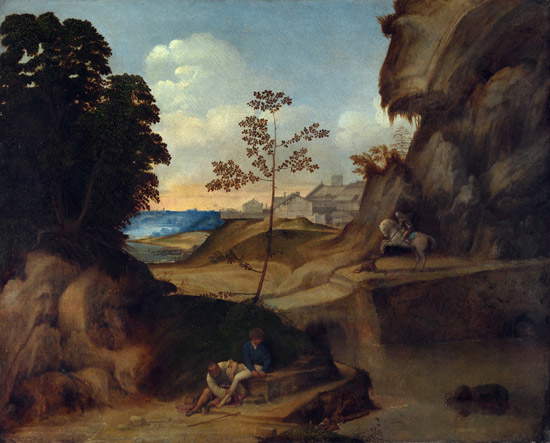 |
| Giorgione, The Sunset (c. 1506-1508; London, National Gallery) |
The light, both natural and innovative, characterizes the painting to such an extent that it prompted Roberto Longhi, in 1934, to suggest the title by which it is now universally known: precisely, the Sunset. Longhi was, moreover, one of the first to attribute the work to Giorgione in the aftermath of its discovery (if we leave aside the Piedmontese art historian’s initial hesitancy, dissolved, however, almost immediately): an attribution that was fully accepted (although it would still give rise to some contestation in the future) when the painting, in 1955, was exhibited at the exhibition on Giorgione, which, moreover, was the last exhibition dedicated to the painter before the 2010 event in Castelfranco Veneto. The work popped up in 1933 from the Villa Garzoni in Pontecasale, a country village halfway between Padua and Rovigo: at the time of the discovery, which is credited to the then director of the Correr Museum in Venice, Giulio Lorenzetti, the villa was owned by the Donà dalle Rose family, but formerly belonged to the Michiels. The latter was the family from which came Marcantonio Michiel, the collector and man of letters who, with his notebooks and descriptions of works he owned or saw in private Venetian collections, has helped modern art historians to reconstruct some of the stages of Giorgione’s biographical and artistic story. It is therefore not unreasonable to speculate, even in the absence of firm evidence, that the Sunset came from the family’s collections. The painting was then purchased in 1934 by the Russian-born art historian Vitale Bloch, who owned it until 1957, when it became part of the National Gallery’s collections following a further sale: this is the story of the work’s transitions.
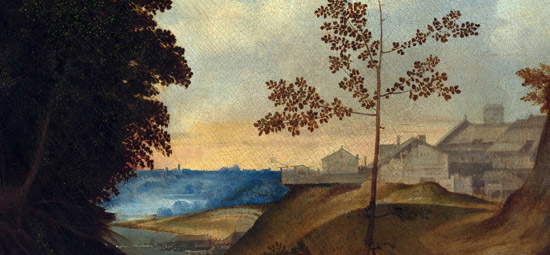 |
| Detail of the sunset over the village |
We have said that the main protagonist of the work is the landscape: however, many have labored to unravel the knot of meaning of the four characters we encounter in the painting. Namely, the old man among the rocks in the cave, the knight slaying the dragon, and the two men sitting in the center: it seems that one of them, the older, is examining the leg of the younger, probably because he is injured. Until not long ago, the most widely accepted interpretation was one that called religion into play: the old hermit in the cave would be St. Anthony Abbot, whose presence would also be explained by the pig, an animal that always accompanies him and appears in the painting in the waters of the pond on the lower edge. The wounded young man in the center would be identified as St. Roch (because of the wound, his typical iconographic attribute), the old man assisting him would be his friend St. Gotthard, and the knight slaying the dragon would be, as is easy to imagine, St. George: they are all saints connected with the cure of diseases, and in this sense the work could be interpreted. The hypothesis was first formulated, in 1975, by Cecil Gould, conservator of the National Gallery, and was then accepted by other art historians. Maurizio Calvesi, in 1970, had proposed identifying the old man in the center as St. James curing a pilgrim, and even earlier Maurizio Bonicatti, in 1964, speculated that the theme was the temptations of St. Anthony, while previously others such as Giorgio Sangiorgi (in 1933) and Lionello Venturi (in 1958) thought of Aeneas and Anchises in the Underworld.
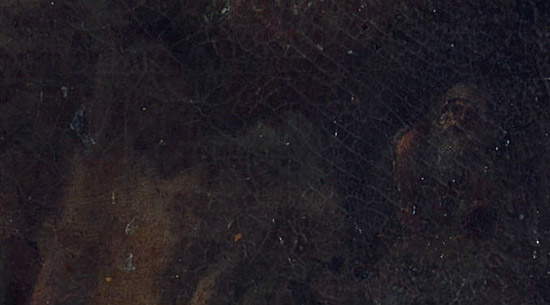 |
| Detail of the old man among the rocks |
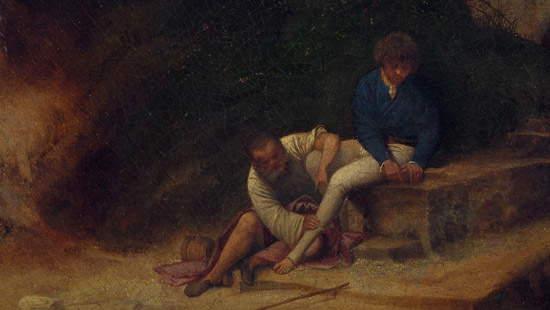 |
| Detail of the two men in the center |
The last hypothesis, a hypothesis that moreover is gaining much ground among scholars, is the one formulated by Enrico Dal Pozzolo in 2009: the scene would tell the myth of Philoctetes, the Greek hero who, during the voyage to Troy, injured his foot during a stopover and, having become a burden to his companions, was abandoned on the island of Lemno. Later, the Greeks returned to take him back because a soothsayer predicted that Troy would not fall unless Philoctetes also participated in the fighting. Moreover, Philoctetes was also the protagonist of a tragedy by Sophocles that had been printed in 1502 in Venice by Aldo Manuzio: it is therefore likely that the publication had aroused some interest in the character among artists as well. The wounded young man in the center would thus, according to this interpretation, be Philoctetes himself, while the man helping him and the old man among the rocks would be two companions: the first one is honest about the young man’s condition, and the other is checking that everything is going well. We can leave out the interpretation related to the figure on horseback: it is in fact, we did not say, aspurious addition. The images accompanying the technical analysis of the painting on the National Gallery website show us how, in 1933, there was no trace of the horseman: it was in fact added after a restoration in 1934, juxtaposing fragments of old canvases, to cover a particularly damaged area of the painting. Therefore, it no longer makes sense to ask why it was there.
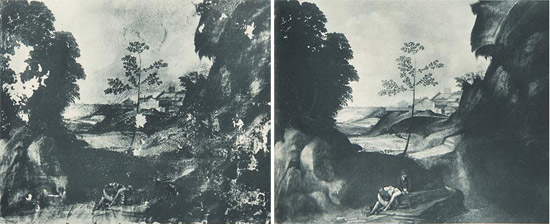 |
| The Sunset before and after the first restoration in 1933. Images from the National Gallery in London |
However, nothing prevents us from thinking that this is a simple pastoral scene set in an idyllic Veneto landscape, one of those gentle country landscapes that characterize the painter’s home region and are a hallmark of his art. A landscape where men are no more than sparse extras. A landscape that is cloaked in amuffled atmosphere, abandoning the detailed descriptions that constituted one of the main characteristics of Giorgione’s early production, and welcoming instead on the one hand a more extensive and capillary use of Leonardo’s sfumato, and on the other a more subjective inspiration (reasons that would have led scholars to a late dating of the work, between 1506 and 1508 or so): after all, to give lyricism to a landscape one must read it and interpret it according to one’s own feeling.
It is precisely this lyricism that distinguishes Giorgionesque landscapes from Nordic landscapes, Flemish above all (even the bird that appears in the waters of the Lake of the Sunset appears to be a clear homage to the imagery of Hieronymus Bosch), which circulated in the Venice of the time and which had prompted painters to create works that even in a beautiful landscape found their raison d’être. So without moralising interpretations, without the need to invent particular allegories to justify a setting, without the need to find a defined subject. Giorgione did it, his contemporaries such as Giulio Campagnola, Bartolomeo Montagna and Cima da Conegliano did it, others would later do it as well. Precisely because in the Venice of the very early years of the sixteenth century there was an increased demand, driven by the arrival of paintings from the Nordic area, for works in which the landscape played a leading role, and sometimes even in which it was the sole protagonist, without the painting having a story to tell. And sometimes isn’t it nice to avoid thinking about possible subjects, and to be carried away by the creative flair of the painter and his ability to captivate the viewer just with a wonderful landscape at sunset?
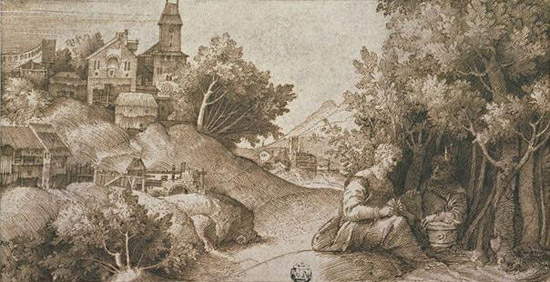 |
| Giulio Campagnola, Landscape with Two Men Seated Near a Wood (c. 1510; Paris, Louvre) |
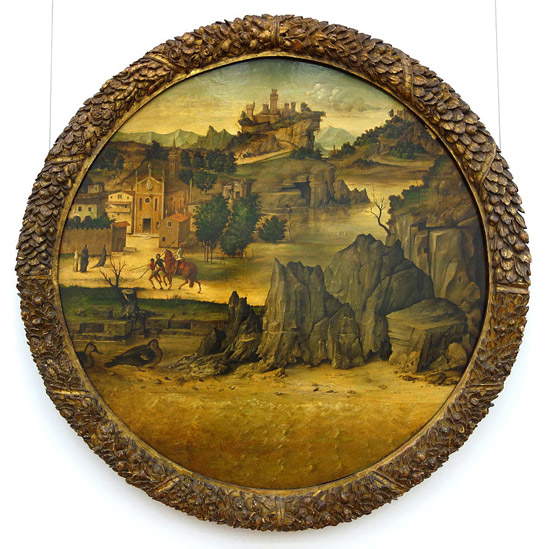 |
| Bartolomeo Montagna, Landscape with Castle (c. 1500-1510; Tokyo, National Museum of Western Art) |
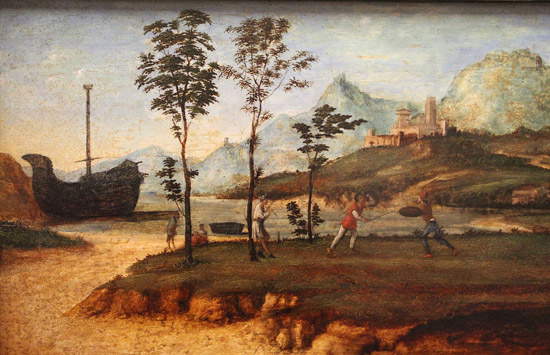 |
| Cima da Conegliano, Landscape with Duel (1510-1515 approx.; Berlin, Gemäldegalerie) |
Warning: the translation into English of the original Italian article was created using automatic tools. We undertake to review all articles, but we do not guarantee the total absence of inaccuracies in the translation due to the program. You can find the original by clicking on the ITA button. If you find any mistake,please contact us.



























